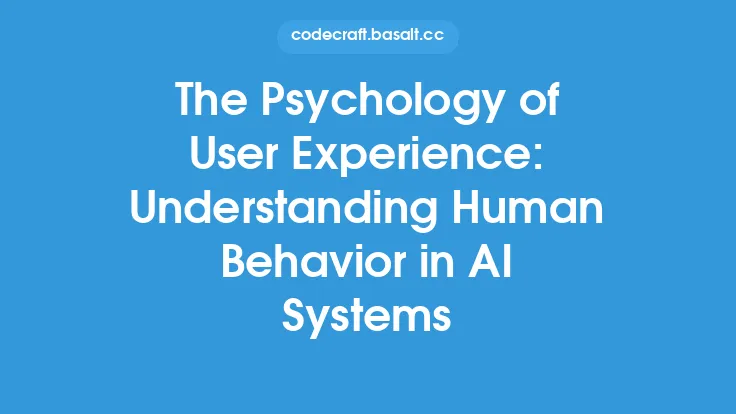Cognitive load management is a crucial aspect of human-computer interaction in AI systems, as it directly impacts user experience and overall system usability. Cognitive load refers to the amount of mental effort required to complete a task, and when it becomes too high, users can experience fatigue, frustration, and decreased productivity. In AI systems, cognitive load can arise from various sources, including complex interfaces, excessive information, and unclear instructions. To mitigate these issues, AI system designers and developers can employ several strategies for reducing user fatigue and improving overall user experience.
Introduction to Cognitive Load Theory
Cognitive load theory (CLT) is a psychological framework that explains how the human brain processes information and allocates mental resources. According to CLT, there are three types of cognitive load: intrinsic, extraneous, and germane. Intrinsic cognitive load is inherent to the task itself and cannot be changed. Extraneous cognitive load is imposed by the way information is presented and can be reduced through proper design. Germane cognitive load is related to the learning process and can be beneficial for users. AI system designers should aim to minimize extraneous cognitive load and optimize germane cognitive load to create an efficient and effective user experience.
Strategies for Reducing Cognitive Load
Several strategies can be employed to reduce cognitive load in AI systems. One approach is to simplify the user interface by removing unnecessary features and minimizing clutter. This can be achieved through the use of intuitive icons, clear typography, and a consistent layout. Another strategy is to provide users with clear and concise instructions, using plain language and avoiding technical jargon. Additionally, AI systems can be designed to provide feedback and guidance to users, helping them to understand the system's capabilities and limitations. This can be achieved through the use of interactive tutorials, contextual help, and real-time feedback.
Information Architecture and Cognitive Load
Information architecture plays a critical role in managing cognitive load in AI systems. A well-designed information architecture can help users to quickly find the information they need, reducing the time and effort required to complete tasks. This can be achieved through the use of clear and consistent categorization, intuitive search functionality, and personalized recommendations. AI systems can also use machine learning algorithms to analyze user behavior and adapt the information architecture to meet individual user needs. For example, a recommendation system can suggest relevant content based on a user's search history and preferences.
Cognitive Load and Decision-Making
Cognitive load can also impact decision-making in AI systems. When users are presented with too many options or complex information, they can experience decision paralysis, leading to decreased productivity and user satisfaction. To mitigate this issue, AI system designers can use techniques such as decision support systems, which provide users with personalized recommendations and guidance. Additionally, AI systems can be designed to provide users with clear and concise summaries of complex information, helping them to make informed decisions. For example, a financial planning AI system can provide users with a summary of their investment options, including the risks and benefits associated with each option.
Technical Approaches to Cognitive Load Management
Several technical approaches can be employed to manage cognitive load in AI systems. One approach is to use machine learning algorithms to analyze user behavior and adapt the system's interface and functionality to meet individual user needs. For example, a machine learning algorithm can be used to predict a user's goals and provide personalized recommendations and guidance. Another approach is to use natural language processing (NLP) to analyze user input and provide clear and concise responses. NLP can also be used to detect user frustration and provide proactive support and guidance. Additionally, AI systems can be designed to use cognitive architectures, such as SOAR and ACT-R, which provide a framework for modeling human cognition and decision-making.
Evaluation and Measurement of Cognitive Load
Evaluating and measuring cognitive load is crucial to ensuring that AI systems are designed to meet user needs. Several methods can be used to evaluate cognitive load, including user surveys, usability testing, and physiological measurements. User surveys can provide insights into user perceptions of cognitive load, while usability testing can provide insights into user behavior and performance. Physiological measurements, such as heart rate and skin conductance, can provide insights into user emotional state and cognitive load. AI system designers can also use machine learning algorithms to analyze user behavior and predict cognitive load, providing proactive support and guidance to users.
Future Directions and Challenges
Cognitive load management is a rapidly evolving field, with several future directions and challenges. One challenge is to develop AI systems that can adapt to individual user needs and preferences, providing personalized support and guidance. Another challenge is to develop AI systems that can detect and respond to user emotions, providing proactive support and guidance. Additionally, AI system designers must balance the need to provide users with clear and concise information with the need to provide users with detailed and complex information. This requires a deep understanding of user needs and preferences, as well as the development of advanced machine learning algorithms and cognitive architectures. As AI systems become increasingly ubiquitous, the need for effective cognitive load management will only continue to grow, making it a critical area of research and development in the field of human-computer interaction.





